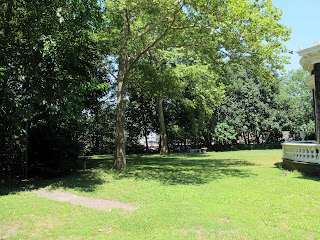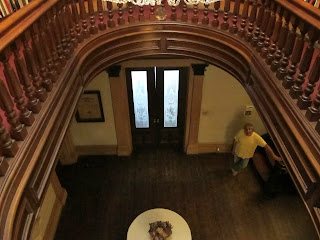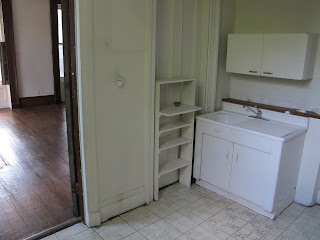
Question: Where was this wonderful mid-nineteenth century Greek Revival country house - at least, until they tore it down in 1964? Or how about the two beauties below - beauty being a relative term - which until 1963 and 1920 respectively stood on a tranquil byway called Shore Road?


Answer: In old Astoria, Queens. Astoria today is an indisputably pleasant neighborhood noted for many things - movie history, pianos, Greek restaurants, good looking gay guys, etc., etc. - but big old houses are not among them. The twentieth century witnessed the literal eradication of an Astoria whose gracious countryside was once a favorite locale for upscale country places.


Here's a late nineteenth century view of the Astoria that no longer exists. We're looking north from about the line of the Grand Central Parkway. La Guardia would be to our right, down that leafy lane in the foreground. The western half of Rikers Island is visible in the distance, with the Port Morris section of the Bronx on the far shore. Look closely for a group of taller trees in the middle of the view on this side of the water, and barely visible amongst them is the shape of a big old house.

Here's that house in the 1930s, gazing wistfully across the no longer tranquil waters between it and the Bronx. Its original 400-acre estate has been whittled down to under an acre and an anonymous photographer, who would have been prosecuted for trespassing twenty years earlier, has paused to snap this candid from the present-day site of a water treatment plant.

Incredibly, one hundred and fifty-six (more or less) years after it was built - by a manufacturer of precision instruments named Benjamin Pike (1809-1864) - this grand old pile is still extant, buried in trees at the north end of 41st Street.

This is not a gatehouse, but rather an outrigger wing of the main house, connected to it by a short columned gallery. A caretaker stays in it today. The gate isn't original, but marks the approximate line of a drive that once swept around the corner of the house and arrived at the front door.

That drive is long gone and one enters the property nowadays via the kitchen court. Let's go through that gallery on the left and head out onto the lawn.



The sweeping water views from the lawn, alas, exist no longer.

In 1874, Pike's widow sold her husband's granite mansion to William Steinway, son of Heinrich Steinweg (later anglesized to Henry Steinway) founder in 1853 of the famous piano building firm that bears the family name. Steinway Jr. was a different sort of country squire from those who had previously summered in Astoria. For openers, he built an enormous new factory, still in operation today, two blocks from his house. Then he converted his fields and orchards into a company town called Steinway Village. The brick row houses built for his workers still stand in Astoria today.







Not only are the walls built of dressed granite, the trim is cast iron.

For most of the last millenia, aristocracies have ruled from country seats. By contrast, rich merchants usually lived amidst the source of their riches. That changed in the nineteenth century, as the nouveau riche began to ape the aristocracy by building country estates of their own. The notion of building your factory next to your house evidently wasn't all that "outre" to a first generation German-American like William Steinway. However, his descendants saw things differently. In 1924, after a half century of family occupancy, they put the house on the market for sale. Thanks in large part to them, it was now a different neighborhood and there were no takers.



Here's the front door of the Steinway mansion from inside. Before we go further, a few words are in order about the mansion's third owner, an Armenian immigrant named Jack Halberian who came to America in 1913. By the mid-1920s, Halberian had built a successful business called Jack's Tailor Shop, located on the corner of Second Ave and 49th Street in Manhattan. On days off in good weather, he and his friends made excursions to the North Beach Amusement Park, a vanished icon of the working class located on the site of LaGuardia Airport. From the trolley en route, the Steinway house was clearly visible across the empty fields that still surrounded it. Halberian bragged to his friends that one day that house would be his. In May of 1926, he bid $45,000 at auction and became the third owner.


There's a sort of Biedermeier thing going on with the woodwork here, but it is entirely unintentional. The pale colored elements are unfinished paint grade pine whose many coats of accumulated paint were stripped, then left unfinished. The last Halberian to live here liked the look.


The glory of the house is the two-story domed hall that thrills today's visitors as much as it did young Jack Halberian almost ninety years ago. By 1926, Halberian had managed to save $10,000, all of which he put down on purchase. He raised the balance by getting a "demand mortgage," due any time the lender chose.

The door from the entry foyer to the main hall contains an etched glass homage to Benjamin Pike's precision instrument business.



The chandelier, which can be hoisted up and down by a motor, is not original.

At the opposite end of the hall, facing the precision instrument doors, is the entrance to the dining room. My host, John Halberian, is contemplating the plasterwork.






Besides the dining room, three additional formal rooms occupy the first floor. This is the library.





Across the hall is a set of double parlors. Jack Halberian's grand existence in his new mansion was abruptly threatened when, in the late 'twenties, his mortgagee demanded payment on the loan. Halberian barely managed to scrape together sufficient funds to avert foreclosure, but his continued financial survival required turning the mansion into a rooming house. The former mortgagee, by the way, put everything into the market, lost it all in the crash, and subsequently committed suicide.



Here's yours truly, in the image for scale. (I'm the one who insisted we leave the lawnmower). The curtains in the second parlor are booty from a long ago movie shot.




The main stair is located in an alcove adjoining the center hall and rises to a gallery under the dome on the second floor.







Four family bedrooms and a corridor leading to a single shared bath lie behind doors letting onto the gallery. Movie shoots are hard on houses, and this one survived no better.



Once a trio of closets, this area became a kitchen during the rooming house period.

A roomer painted the marble fireplace white, and succeeding Halberians have been trying to remove the paint ever since.


All four bedrooms are connected by internal doors, in addition to the individual doors on the gallery. That's the master bedroom ahead. The view from its windows, once of fields and woodlands, is now of an industrial district of northern Queens.



There is only one old bathroom. A second was added in the 1970s.


A servants' stairway leads to the third floor, notable for the dome that covers the main hall, and a trio of grim servants' rooms better suited to the confinement of insane relatives.



The Italianate tower contains one of those intriguing yet apparently purposeless rooms for which we yearn to come up with a use. I am informed by a reader, however, that with their windows open these tower rooms functioned as summertime ventilation chimneys, sucking hot air from the lower floors while inducing a cooling indoor breeze. The view from up here includes a glimpse of the bridge over Bowery Bay (I want to call it Botany Bay) to Rikers Island, with the Whitestone Bridge in the distance. A final spiral leads to a cupola with a locked door.




Time to head downstairs to the serving pantry - practically a full kitchen in itself - located next to the dining room on the main floor. It is connected to the main basement kitchen by a dumbwaiter. How great is that 1940s refrigerator?




The basement stairs lead to the former main kitchen and a series of 1980s "spa" rooms - hot tub, sauna, party rooms, etc. - which look, anomalously, like the "pad" of a Wild and Crazy Guy.




Why it is still called the Steinway Mansion is a minor mystery, since the Halberians have owned it for eighty-six years, compared to the Steinways' fifty. After Jack Halberian died in 1976, his son Michael - at various times, an elite men's haberdasher and restauranteur - moved in and doted on the place until his death in 2010. We owe the building's present existence - it is a designated New York City landmark, by the way - to the love and dedication of this one family. The Steinway Mansion has been on the market for sale since Michael Halberian's death, the price declining from a bit under five million to two and a half million today. Finding a purchaser is as problematic now as it was in 1926. The city and the local historical society are both broke. The obvious candidate - the Steinway Piano Factory operating at full tilt two blocks away - has so far expressed no interest.

Many thanks to John Halberian for the tour and background information on his family, and to Bob Singleton of the Greater Astoria Historical Society for the use of vintage images and for this unusual video. Here's the link: http://www.youtube.com/watch?v=ox-Oy4OLc34
The loss of those country homes in Astoria, overlooking the East River including Lambert Castle, is unfortunate and hopefully the fate of the Steinway Mansion will be different. What a magnificent period interior and so close to the bustling metropolis, but seemingly a world away. Someone needs to love this home as well as the previous family did.
ReplyDeleteA Facebook friend linked to this terrific blog! I just spent several hours poring over your recent posts and have only gotten to late May. I often walk my dog at Mills Mansion and other old estates in & around Rhinebeck; now I want to go inside.
ReplyDeleteDear John,
ReplyDeleteThank you for this informative and well-illustrated post. Perhaps you are already aware, but part of the Italianate house with two-story portico and octagonal cupola, illustrated in the first picture included in your post, survives at the Metropolitan Museum of Art. The Met removed architectural elements from one of the two parlors before the residence was demolished and installed them in a room created as part of the American Wing’s sequence of eighteenth- and nineteenth-century American period rooms. Curators in the American decorative arts department furnished the room to represent an upper-class New York parlor of the mid-nineteenth century. The parlor now contains an incredible suite of Rococo Revival laminated rosewood furniture attributed to New York City cabinetmaker John Henry Belter. The parlor suite and many other furnishings in the Rococo Revival style lend this period room its name, "The Rococo Revival Parlor." The room is presented in conjunction with other period interiors dating between 1830 and 1870, including the Greek Revival Parlor, the Gothic Revival Library and the Renaissance Revival Parlor.
According to the 1996 publication "Period Rooms in the Metropolitan Museum of Art," a man named Horace Whittemore built in 1852 the elegant Italianate villa of which the Rococo Revival Parlor was once part. His house stood at 4-17 Twenty-Seventh Avenue in Astoria.
By the way, I'll take the Pike-Steinway-Halberian house!
Cheers,
Walter Ritchie
Mike wanted someone who would love the house as much as he did. The view from the tower is not to be believed. Also you can visit http://www.modernartfoundry.com/ it at the bottom of the hill. There is an other house on 41 st http://www.trulia.com/property/3078249036-2165-41st-St-Astoria-NY-11105
DeleteDear Mr. Ritchie - I can't wait to get to the Met and see this room. Thank you so much for the "heads up," and for locating the exact address of the Whittemore house. I've poked around Astoria just a little, and have actually found the odd block of old houses. One is 12th Street between 27th and 26th Aves, virtually around the corner from Whittemore's site. P.S. The Halberians would love you to take on the Steinway House; don't be shy!...JF
ReplyDeleteDear John,
DeleteI am sure you will enjoy the Rococo Revival Parlor. The furnishings are not original to the Whittemore house, but this period room is an excellent representation of a parlor in an affluent New York City home of the 1850s.
You may enjoy my two blogs considering your interest in old houses.
http://19thcenturyupstatenewyorkinteriors.blogspot.com/
http://athomeinthenineteenthcentury.blogspot.com/
Wow, what an amazing home :)
ReplyDeleteHere is a Queens Gazette article of what was inside:
ReplyDeletehttp://www.qgazette.com/news/2011-03-30/Front_Page/Steinway_Mansion_Bounty_Goes_To_Auction.html